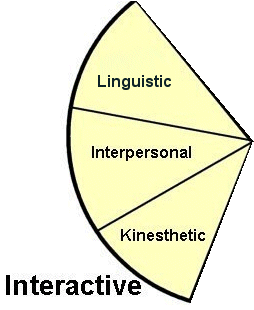THE INTERACTIVE DOMAIN

THE INTERACTIVE DOMAIN

The interactive domain consists of the linguistic, interpersonal, and kinesthetic intelligences. These are the intelligences that learners typically employ to express themselves and explore their environment.
Consider five year old Selange in his Kindergarten classroom. He not only uses language to demonstrate his knowledge or express his needs, he also uses language to explore, inquire and prompt responses from others. This can include the use of nonsensical expressions, repetitive recountings of favorite books, and even reverting to "baby talk". Regardless of the many functions of language Selange is using, he consistently makes use of talk to interact with others and his environment.
Eleven year old Selina is a prime example of the interactive function of the interpersonal intelligence. As her class reads E.G. Speare's The Witch of Blackbird Pond she continually prompts her teacher to ask about the mores of seventeenth century New England. Selina initiates class discussion on the social dynamics of prosecuting witches in Colonial New England, not for the sake of the discussion itself but to help her better understand the plot and setting of the story. When it comes time to be assessed for comprehension of the novel, Selina excels in an interview format, in which she can discuss her understandings and ideas at length. In fact, her teacher is offering several assessment options, including the opportunity to be interviewed by a classmate as the heroine from the book.
Finally, consider Susan's use of her kinesthetic intelligence as an interactive process. Susan has been learning about electrical circuits in her third grade class. This week the teacher has set up an experiment as a learning center where Lin and her classmates must use batteries, copper wiring and light bulbs to create electrical circuits. Susan and her group of three classmates quickly create a complete circuit. They then ask their teacher Mrs. Morales for some paper clips so that they can experiment making a switch that will open and close the circuit. Finally Susan and her group take the experiment a step further by creating a parallel circuit using two light bulbs. Susan has repeatedly interacted with her environment and her peers to create a greater understanding of how electrical circuits work.
I characterize these three intelligences as interactive because even though they can be stimulated through passive activity they typically invite and encourage interaction to achieve understanding. Even if a student completes a task individually, s/he must consider others through the way s/he writes, creates, constructs and makes conclusions. The interactive intelligences are by their nature social processes.
http://surfaquarium.com/MI/mi_domain_interactive.htm
Copyrightę2002-2014
No
portion of this page may be cited, copied, repreinted or distributed
without written permission